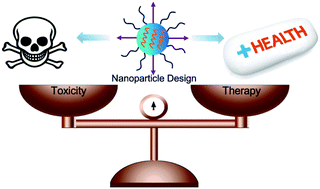当前位置:
X-MOL 学术
›
Nanoscale Horiz.
›
论文详情
Our official English website, www.x-mol.net, welcomes your
feedback! (Note: you will need to create a separate account there.)
Computational approaches to cell–nanomaterial interactions: keeping balance between therapeutic efficiency and cytotoxicity
Nanoscale Horizons ( IF 8.0 ) Pub Date : 2017-10-03 00:00:00 , DOI: 10.1039/c7nh00138j Hong-ming Ding 1, 2, 3, 4 , Yu-qiang Ma 1, 2, 3, 4, 5
Nanoscale Horizons ( IF 8.0 ) Pub Date : 2017-10-03 00:00:00 , DOI: 10.1039/c7nh00138j Hong-ming Ding 1, 2, 3, 4 , Yu-qiang Ma 1, 2, 3, 4, 5
Affiliation

|
Owing to their unique properties, nanomaterials have been widely used in biomedicine since they have obvious inherent advantages over traditional ones. However, nanomaterials may also cause dysfunction in proteins, genes and cells, resulting in cytotoxic and genotoxic responses. Recently, more and more attention has been paid to these potential toxicities of nanomaterials, especially to the risks of nanomaterials to human health and safety. Therefore, when using nanomaterials for biomedical applications, it is of great importance to keep the balance between therapeutic efficiency and cytotoxicity (i.e., increase the therapeutic efficiency as well as decrease the potential toxicity). This requires a deeper understanding of the interactions between various types of nanomaterials and biological systems at the nano/bio interface. In this review, from the point of view of theoretical researchers, we will present the current status regarding the physical mechanism of cytotoxicity caused by nanomaterials, mainly based on recent simulation results. In addition, the strategies for minimizing the nanotoxicity naturally and artificially will also be discussed in detail. Furthermore, we should notice that toxicity is not always bad for clinical use since causing the death of specific cells is the main way of treating disease. Enhancing the targeting ability of nanomaterials to diseased cells and minimizing their side effects on normal cells will always be hugely challenging issues in nanomedicine. By combining the latest computational studies with some experimental verifications, we will provide special insights into recent advances regarding these problems, especially for the design of novel environment-responsive nanomaterials.
中文翻译:

细胞-纳米材料相互作用的计算方法:在治疗效率和细胞毒性之间保持平衡
由于其独特的性能,纳米材料由于具有明显优于传统材料的固有优势,因此已广泛用于生物医学。但是,纳米材料也可能导致蛋白质,基因和细胞功能障碍,导致细胞毒性和遗传毒性反应。最近,人们越来越关注纳米材料的这些潜在毒性,尤其是纳米材料对人类健康和安全的危害。因此,当将纳米材料用于生物医学应用时,保持治疗效率和细胞毒性之间的平衡非常重要(即,提高治疗效率并降低潜在的毒性)。这要求对纳米/生物界面上各种类型的纳米材料与生物系统之间的相互作用有更深入的了解。在这篇综述中,我们将从理论研究者的角度出发,主要基于最近的模拟结果,介绍由纳米材料引起的细胞毒性的物理机制的现状。另外,还将详细讨论自然地和人为地使纳米毒性最小化的策略。此外,我们应该注意到毒性并不总是对临床有用,因为引起特定细胞的死亡是治疗疾病的主要方法。增强纳米材料对患病细胞的靶向能力并将其对正常细胞的副作用降到最低,将一直是纳米医学面临的巨大挑战。通过将最新的计算研究与一些实验验证相结合,我们将对有关这些问题的最新进展提供特别的见解,尤其是对于新型对环境敏感的纳米材料的设计。
更新日期:2017-10-03
中文翻译:

细胞-纳米材料相互作用的计算方法:在治疗效率和细胞毒性之间保持平衡
由于其独特的性能,纳米材料由于具有明显优于传统材料的固有优势,因此已广泛用于生物医学。但是,纳米材料也可能导致蛋白质,基因和细胞功能障碍,导致细胞毒性和遗传毒性反应。最近,人们越来越关注纳米材料的这些潜在毒性,尤其是纳米材料对人类健康和安全的危害。因此,当将纳米材料用于生物医学应用时,保持治疗效率和细胞毒性之间的平衡非常重要(即,提高治疗效率并降低潜在的毒性)。这要求对纳米/生物界面上各种类型的纳米材料与生物系统之间的相互作用有更深入的了解。在这篇综述中,我们将从理论研究者的角度出发,主要基于最近的模拟结果,介绍由纳米材料引起的细胞毒性的物理机制的现状。另外,还将详细讨论自然地和人为地使纳米毒性最小化的策略。此外,我们应该注意到毒性并不总是对临床有用,因为引起特定细胞的死亡是治疗疾病的主要方法。增强纳米材料对患病细胞的靶向能力并将其对正常细胞的副作用降到最低,将一直是纳米医学面临的巨大挑战。通过将最新的计算研究与一些实验验证相结合,我们将对有关这些问题的最新进展提供特别的见解,尤其是对于新型对环境敏感的纳米材料的设计。









































 京公网安备 11010802027423号
京公网安备 11010802027423号